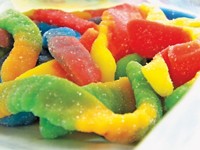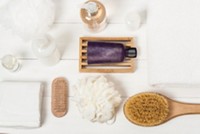Advertisement
Grab your lab coat. Let's get started
Welcome!
Welcome!
Create an account below to get 6 C&EN articles per month, receive newsletters and more - all free.
It seems this is your first time logging in online. Please enter the following information to continue.
As an ACS member you automatically get access to this site. All we need is few more details to create your reading experience.
Not you? Sign in with a different account.
Not you? Sign in with a different account.
ERROR 1
ERROR 1
ERROR 2
ERROR 2
ERROR 2
ERROR 2
ERROR 2
Password and Confirm password must match.
If you have an ACS member number, please enter it here so we can link this account to your membership. (optional)
ERROR 2
ACS values your privacy. By submitting your information, you are gaining access to C&EN and subscribing to our weekly newsletter. We use the information you provide to make your reading experience better, and we will never sell your data to third party members.
Consumer Products
What’s that Stuff
What’s inside toothpaste tablets, and can they clean your teeth effectively?
Originally a niche product for the zero-waste crowd, these pressed powder pills are the latest in a string of popular tooth-cleaning options
by Craig Bettenhausen
July 9, 2023
| A version of this story appeared in
Volume 101, Issue 22

Dental hygiene aficionados have surely noticed a new format battling for a share of the oral hygiene market. Toothpaste tablets are dry, pressed-powder pills about the size of an aspirin or a pea. With a solid chomp from the molars, the tablet turns into a powder that mixes with saliva to make a foamy paste.
From there, the procedure is what most people are used to: brush all surfaces of the teeth and gums for about 2 min—one playthrough of Weird Al’s song “I Want a New Duck” is about right—then after a quick pass on the tongue and roof of the mouth, spit, rinse, and spit.
As of June 2023, toothpaste tablets cost 10–20 cents per bite—nothing that’ll break the bank for most brushers but 5–20 times as expensive as conventional toothpaste.
This new dentifrice, a term encompassing anything you rub on your teeth to clean them, came on the scene a few years ago. The tablets were originally a niche product for the zero-waste crowd, marketed as a way to eliminate the plastic waste associated with tubes of conventional toothpaste. But waterless products are trending in the personal care market, and with more than 100 varieties to choose from, people may be wondering: What exactly are toothpaste tablets?
Recipes vary widely, but as with regular toothpastes, the tablet formulations usually contain abrasives to slough off stains and debris, surfactants to help wash away food and grime, binders to hold the formulation together, and sweeteners and flavorings for taste.
A sample formulation from the personal care ingredient supplier Jungbunzlauer details that approach. The first ingredient, weighing in at about 45% of the total, is sweetener. Jungbunzlauer’s choice is a blend of the sugar alcohol erythritol and steviol glycosides derived from the stevia plant. Other tooth-tab makers might use xylitol, sorbitol, and mannitol as well.
In addition to improving taste, the sweetener components serve as a binder, helping the tablets hold together till it’s time to brush. Sugar alcohols work well because, besides being sweet, their crystals fuse under the pressure exerted by the pill-making machines. Some also aren’t very hygroscopic, so they won’t soak up humidity from the air and make the tabs mushy—a characteristic that’s becoming a key differentiator between competing brands.
Stevia extract and sugar alcohols also offer mild surfactant action, helping hydrophobic grime and food remnants mix with water and wash away. Some research also suggests that xylitol fights tooth decay by making it harder for microbes to adhere to teeth, though the American Dental Association (ADA) has yet to endorse that notion (BMC Oral Health 2010, DOI: 10.1186/1472-6831-10-22).
Sweeteners take more of a back seat in conventional toothpaste, where glycerin, water, and abrasives make up a larger percentage of the formula. Supersweet ingredients such as stevia and saccharin are more common in tube toothpaste, though sugar alcohols are certainly in the formulator’s standard palette.
The main surfactant in the sample formulation is cocamidopropyl betaine, a workhorse biobased surfactant in the personal care industry. But you don’t need much—around 1% in many recipes. Tabs don’t use the dominant surfactant in normal toothpaste, sodium lauryl sulfate (SLS), because it works best in liquids. That’s good news for those that brush before breakfast, because SLS is the ingredient that makes orange juice taste terrible after brushing.
Kelly Dobos, a freelance formulation chemist, says that the cleaning power of any dentifrice comes from surfactants and abrasives. Indeed, the abrasives in Jungbunzlauer’s formulation add up to 46% of the total mass. The abrasive roster includes calcium carbonate, modified and natural celluloses, and sodium bicarbonate. Alumina is another common choice, as are other food-safe minerals, and tablets tend to be made with the same basic set of abrasives as tube toothpastes are.
Dobos says that an ideal abrasive is just a bit softer than the minerals in teeth, intuitively enough. The main component of tooth enamel is hydroxyapatite, Ca5(PO4)3OH, which scores a 5 on the Mohs scale, a measurement of hardness in materials science. That score leaves a lot of options—common types of steel score between 4 and 4.5. Calcium carbonate is a 3, and sodium bicarbonate comes in at 2.5, similar to fingernails. Silica is also used, but it’s an ingredient to be careful with. With a score of around 6.5 on the Mohs scale, the exact shape of the silica grains determines whether or not the grains are safe on teeth.
One ingredient often absent in the current selection of toothpaste tablets is fluoride. That’s partly a branding choice made to please customers suspicious of fluoride; though the health and mind-control dangers of fluoride are not well borne out by serious study, adherents of those concerns overlap heavily with toothpaste tablets’ core market of ecoconscious consumers.
Another reason for a tablet maker to skip fluoride is that including it gives a dentifrice a formal anticavity claim. Fluoride is the only ingredient that gives a brand the right to make that claim in the US, Dobos says. The US Food and Drug Administration has approved stannous fluoride, sodium fluoride, and sodium monofluorophosphate to add decay prevention in toothpaste. But that means the agency regulates any dentifrice with an anticavity claim as an over-the-counter drug.
A dentifrice without fluoride is considered a cosmetic, and rules for cosmetics are far less stringent regarding manufacturing practices, clinical trials, and other requirements. Though including fluoride could dramatically widen the customer pool and may eventually earn a tablet the endorsement of the ADA, the regulatory burden can be too much for fledgling product makers.
Dobos says anyone considering tabs should pick one with fluoride, because the benefits are settled science. The ADA agrees with that sentiment but has not yet approved any toothpaste tablet, citing a lack of adequate clinical data on efficacy.
If tablets do ever take over the mouth market, they’ll be the latest in a string of popular tooth-cleaning solutions, according to Scott Swank, a professor at the University of Maryland School of Dentistry and the curator of the National Museum of Dentistry.
A predecessor to the toothpaste widely used today was a much thicker product that came in clay and porcelain pots. These formulations emerged in the 1800s and were one of the first mass-manufactured consumer goods. “You would wet your toothbrush and scrape it around on the top of that to get some on your toothbrush, and then brush your teeth,” Swank says. The growth in these products coincided with new technology for printing on glazed ceramics, and the museum has an impressive collection of toothpaste lids from the time.
The familiar tube that tablets seek to unseat came onto the dental hygiene scene between 1887 and 1892, Swank says. It was adapted from tube packaging for artists’ paints, which was patented in 1841. Originally metal, the tubes became plastic—along with so many other consumer products in the mid-20th century.
Earlier water-free products included hard bricks of material about the size of a bar of soap that were briefly popular around the turn of the 20th century. They were also called toothpaste tablets, and instructions for their use were the same as for the toothpaste in pots. Tooth powders that one sprinkled on a brush were also in vogue around World Wars I and II.
While dental care products changed over the years, the basic components remained a cleanser, an abrasive, and binder, Swank says. But as is a pattern in the personal care industry, various “hero ingredients” came in and out of style to add special effects.
In the middle of the 20th century, brands touted boric acid and chlorophyll as whiteners, for example. Many tooth powders were proudly labeled “ammoniated.” “What that really means is it has either urea or uric acid in it,” Swank says. “And putting urine in dentifrice goes back to the Greeks and the Romans. It’s an astringent. Actually, it’s good for the gums. Although the idea is disgusting, it did actually work.”
The first scientific and clinical studies on fluoride came out in the late 1940s and early ’50s. By the ’60s, fluoridated toothpaste in tubes became the dominant dentifrice in most regions.
As for this latest development in dentifrice, toothpaste tablets are still an emerging product sold mostly online to a relatively small customer base. A 2021 article in the British newspaper The Guardian estimated the global market that year at $20 million, compared with $18 billion for toothpaste overall.
But that may be set to change as economies of scale reduce prices, more brands reach the manufacturing sophistication needed to include fluoride, and consumer concerns about plastic waste grow. The little dentifrice dose may be poised to take a bigger bite of the pie.
CORRECTION:
This story was updated on July 21, 2023, to correct the description of silica abrasives. The silica most commonly used in toothpastes is amorphous, not crystalline.




Join the conversation
Contact the reporter
Submit a Letter to the Editor for publication
Engage with us on Twitter